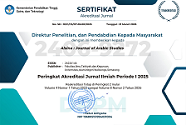Kahoot Gamification: Fostering Critical Thinking in Arabic Listening Comprehension
DOI:
https://doi.org/10.21580/alsina.7.1.28086Keywords:
Arabic language learning, Arabic listening comprehension, critical thinking, digital pedagogy, Kahoot gamificationAbstract
In the era of digital transformation, education increasingly demands innovative pedagogical approaches that not only enhance language proficiency but also cultivate students’ critical thinking skills. This study explores how Kahoot gamification supports the development of critical thinking in Arabic listening comprehension. The research employed a qualitative approach with a single instrumental case study design to examine the integration of Kahoot-based learning activities and their cognitive outcomes. Data were collected through participant observation, documentation, and interviews involving 39 undergraduate students from the Faculty of Sharia, UIN Maulana Malik Ibrahim Malang, class of 2024. The data were analyzed using the interactive model of Miles and Huberman to identify indicators of critical thinking based on Facione’s six dimensions: interpretation, analysis, evaluation, inference, explanation, and self-regulation. The findings revealed that Kahoot gamification was implemented through four learning activities: song playback, simple dialogue, short film, and short story. Each activity stimulated distinct aspects of critical thinking, with song and short film activities generating the most active responses. The study suggests that Kahoot gamification may serve as an effective pedagogical tool to foster engagement and higher-order thinking in Arabic listening instruction, particularly for beginner-level learners.
Downloads
References
Aibar-Almazán, Agustín et al. “Gamification in The Classroom: Kahoot! As a Tool for University Teaching Innovation.” Frontiers in Educational Psychology 15 (2024). https://doi.org/10.3389/fpsyg.2024.1370084.
Al-Mutairi, Tariq G. “Inspecting The Role of Learning Platforms, Gamification, and Diverse Teaching Approaches in Improving Vocabulary Acquisition, Critical Thinking, and Student Engagement in Education.” Journal of Research Studies in English Language Teaching and Learning 2, no. 5 (2024): 283–95. https://doi.org/10.62583/rseltl.v2i5.59.
Alamer, Abdullah, and Fakieh Alrabai. “The Causal Relationship between Learner Motivation and Language Achievement: New Dynamic Perspective.” Applied Linguistics 44, no. 1 (2023): 148–68. https://doi.org/10.1093/applin/amac035.
Aljebreen, Saad, and Aseel Alzamil. “The Impact of Using Short Films on Learning Idioms in EFL Classes.” World Journal of English Language 12, no. 7 (2022): 250–64. https://doi.org/10.5430/wjel.v12n7p250.
Almelhes, Sultan A. “Gamification for Teaching The Arabic Language to Non-Native Speakers: A Systematic Literature Review.” Frontiers in Education 9 (2024). https://doi.org/10.3389/feduc.2024.1371955.
Angelelli, Claudia Viviana et al. “Developing Critical Thinking Skills Through Gamification.” Thinking Skills and Creativity 49 (2023): 101354. https://doi.org/10.1016/j.tsc.2023.101354.
Bağ, Hatice Kübra, and Esim Gürsoy. “The Effect of Critical Thinking Embedded English Course Design to The Improvement of Critical Thinking Skills of Secondary School Learners.” Thinking Skills and Creativity 41 (2021): 100910. https://doi.org/10.1016/j.tsc.2021.100910.
Bai, Shurui et al. “Does Gamification Improve Student Learning Outcome? Evidence from a Meta-Analysis and Synthesis of Qualitative Data in Educational Contexts.” Educational Research Review 30 (2020): 100322. https://doi.org/10.1016/j.edurev.2020.100322.
Bennett, Michael Timothy. “On the Computation of Meaning, Language Models and Incomprehensible Horrors.” In Artificial General Intelligence, edited by Patrick Hammer, Marjan Alirezaie, and Claes Strannegård, 13921:32–41. Lecture Notes in Computer Science. Cham: Springer, 2023. https://doi.org/10.1007/978-3-031-33469-6_4.
Chen, Meng et al. “Language Learning Through Music on the Academic Achievement, Creative Thinking, and Self-Esteem of the English as a Foreign Language (EFL) Learners.” Acta Psychologica 247 (2024): 104318. https://doi.org/10.1016/j.actpsy.2024.104318.
Chen, Xieling et al. “Metacognition Research in Education: Topic Modeling and Bibliometrics.” Educational Technology Research and Development 73, no. 3 (2025): 1399–1427. https://doi.org/10.1007/s11423-025-10451-8.
Dehghanzadeh, Hojjat et al. “Using Gamification to Support Learning English as a Second Language: A Systematic Review.” Computer Assisted Language Learning 34, no. 7 (2021): 934–57. https://doi.org/10.1080/09588221.2019.1648298.
Du, Jing et al. “Enhancing Online Learning Through Multi-Agent Debates for CS University Students.” Applied Sciences 15, no. 11 (2025): 5877. https://doi.org/10.3390/app15115877.
Facione, Peter A. “Critical Thinking: What It Is and Why It Counts.” Insight Assessment, 2015. https://www.law.uh.edu/blakely/advocacy-survey/Critical Thinking Skills.pdf.
Huang, Lu et al. “Enabling and Inhibiting Factors of the Continuous Use of Mobile Short Video APP: Satisfaction and Fatigue as Mediating Variables Respectively.” Psychology Research and Behavior Management 16 (2023): 3001–17. https://doi.org/10.2147/PRBM.S411337.
James, Trixie et al. “Reflective Minds, Brighter Futures: Empowering Critical Reflection with a Guided Instructional Model.” Journal of University Teaching and Learning Practice 20, no. 6 (2023). https://doi.org/10.53761/1.20.6.9.
Jasni, Siti Rohani et al. “Pendekatan Gamifikasi Dalam Pembelajaran Bahasa Arab.” JFatwa: Journal of Fatwa Management and Research 13, no. 1 (2018). https://doi.org/10.33102/jfatwa.vol13no1.165.
Kamsinah, Dessy Laila et al. “Analysis of Critical Thinking Skills in Junior High School Students.” Journal of Advances in Educational and Philosophy 4, no. 6 (2020): 234–37. https://doi.org/10.36348/jaep.2020.v04i06.002.
Khaldi, Amina et al. “Gamification of E-Learning in Higher Education: A Systemic Literature Review.” Smart Learning Environments 10, no. 10 (2023). https://doi.org/10.1186/s40561-023-00227-z.
Laird-Gentle, Alexandra et al. “Systematic Quantitative Literature Review of The Dialogic Pedagogy Literature.” The Australian Journal of Language and Literacy 46 (2023): 29–51. https://doi.org/10.1007/s44020-022-00029-9.
Liang, Weijun, and Dennis Fung. “Fostering Critical Thinking in English-as-a-Second-Language Classrooms: Challenges and Opportunities.” Thinking Skills and Creativity 39 (2021): 100769. https://doi.org/10.1016/j.tsc.2020.100769.
Lim, Nikki Zhi Li et al. “A Systematic Review of Digital Storytelling in Language Learning in Adolescents and Adults.” Education and Information Technologies 27 (2022): 6125–55. https://doi.org/10.1007/s10639-021-10861-0.
Magno, Carlo. “The Role of Metacognitive Skills in Developing Critical Thinking.” Metacognition and Learning 5 (2010): 137–56. https://doi.org/10.1007/s11409-010-9054-4.
McGowan, Lucy D’Agostino et al. “Design Principles for Data Analysis.” Journal of Computational and Graphical Statistics 32, no. 2 (2023): 754–61. https://doi.org/10.1080/10618600.2022.2104290.
Miles, Matthew B. et al. Qualitative Data Analysis: A Methods Sourcebook. 3rd ed. California: SAGE Publications, Inc, 2014.
Petrusly et al. “The Effect of Gamification Using Kahoot on Students’ Critical Thinking Abilities: The Role of Mediating Learning Engagement and Motivation.” Educational Administration: Theory and Practice 30, no. 5 (2024). https://doi.org/10.53555/kuey.v30i5.1524.
Pingmuang, Pawarit, and Prakob Koraneekij. “Mobile-Assisted Language Learning Using Task-Based Approach and Gamification for Enhancing Writing Skills in EFL Students.” EJEL: The Electronic Journal of e-Learning 20, no. 5 (2022): 623–38. https://doi.org/10.34190/ejel.20.5.2339.
Ponna, Afra Siti Annisa et al. “Kemampuan Berpikir Kritis Melalui Metode Predict-Observe-Explain Berbantuan Aplikasi Kahoot.” Jurnal Perspektif 6, no. 1 (2022): 41–51. https://doi.org/10.15575/jp.v6i1.166.
Precedence Research. “E-Learning Services Market Size and Forecast 2025 to 2034.” Precedence Research, 2025. https://www.precedenceresearch.com/e-learning-services-market.
Putz, Lisa-Maria et al. “Can Gamification Help to Improve Education? Findings from a Longitudinal Study.” Computers in Human Behavior 110 (2020): 106392. https://doi.org/10.1016/j.chb.2020.106392.
Riwayatiningsih, Rika et al. “Empowering Higher-Order Thinking Skills in Writing through Gamification and Multimodal Learning within PBL.” Forum for Linguistic Studies 7, no. 2 (2025): 385–98. https://doi.org/10.30564/fls.v7i2.8119.
Saniyyah, Azzah et al. “Comic Media on Arabic Language Learning Speaking Skills: The Analysis of Students’ Creative Thinking.” Eralingua: Jurnal Pendidikan Bahasa Asing Dan Sastra 8, no. 2 (2024): 408–24. https://doi.org/10.26858/eralingua.v8i2.64940.
Sarwanto et al. “Critical Thinking Skills and Their Impacts on Elementary School Students.” Malaysian Journal of Learning and Instruction 18, no. 2 (2021): 161–87. https://doi.org/10.32890/mjli2021.18.2.6.
Scrivener, Jim. Learning Teaching. 2nd ed. Oxford: Macmillan Education LTD, 2005.
Thurairasu, Vanitha. “Gamification-Based Learning as The Future of Language Learning: An Overview.” EJ-Social: European Journal of Humanities and Social Sciences 2, no. 6 (2022): 62–69. https://doi.org/10.24018/ejsocial.2022.2.6.353.
Veen, Mario. “Creative Leaps in Theory: The Might of Abduction.” Advances in Health Sciences Education 26 (2021): 1173–83. https://doi.org/10.1007/s10459-021-10057-8.
Yabukoshi, Tomoko. “Self-Regulation and Self-Efficacy for the Improvement of Listening Proficiency Outside the Classroom.” The Language Learning Journal 49, no. 1 (2021): 27–40. https://doi.org/10.1080/09571736.2018.1472626.
Yin, Robert K. Studi Kasus: Desain & Metode. Jakarta: PT Raja Grafindo Persada, 2012.
Downloads
Published
How to Cite
Issue
Section
License

This work is licensed under a Creative Commons Attribution-NonCommercial-ShareAlike 4.0 International License.
Copyright
The copyright of the received article shall be assigned to the publisher of the journal. The intended copyright includes the right to publish the article in various forms (including reprints). The journal maintains the publishing rights to published articles. Authors are allowed to use their articles for any legal purposes deemed necessary without written permission from the journal, but with an acknowledgment to this journal of initial publication.
Licensing
In order for Alsina: Journal of Arabic Studies to publish and distribute research articles, the editors need publishing rights (transferred from author to publisher). This agreement relates to the transfer/publishing copyright license to Alsina: Journal of Arabic Studies but the authors still have significant rights to use and share their published articles.
Alsina: Journal of Arabic Studies supports the need for writers to share, disseminate and maximize the impact of their research and their rights on any database. As a journal article writer, you have the right to various uses of your articles, including that by the institution or company where you work. Copyright can be used without the need for special permission. Authors who publish articles in the Alsina: Journal of Arabic Studies have broad rights to use their work for teaching and scientific purposes without requesting permission, including:
- Use by the author for lectures, presentations, or conferences, with distribution of copies to participants;
- Distribution to colleagues for research use;
- Use in compilations of the author's subsequent work;
- inclusion in a thesis or dissertation;
- Reuse of sections or excerpts from articles in other works (with full acknowledgment of the final article);
- Preparation of derivative works (other than commercial purposes) (with full acknowledgment of the final article);
- Voluntary posting on open websites operated by authors’ or writers' agencies for scientific purposes
When submitting a manuscript, authors do so on the understanding that if accepted for publication, the copyright for publishing (publishing right) of the article shall be assigned/transferred to Alsina: Journal of Arabic Studies.
Authors whose articles are accepted for publication will receive confirmation via email and sent a Copyright Transfer Agreement.

 Accreditation
Accreditation 
 In Collaboration with
In Collaboration with 

 Visitors
Visitors  Article Template
Article Template





